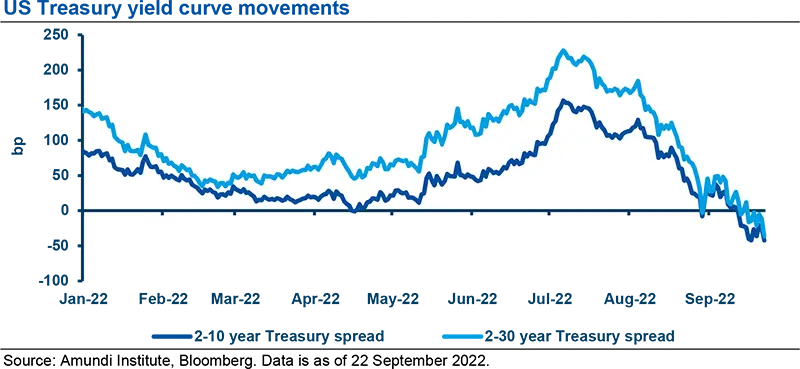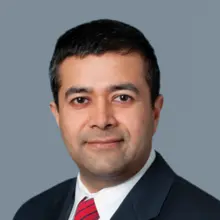Summary
- The Federal Open Market Committee (FOMC) meeting and statement: On 21 September, the Fed hiked the Fed funds rate by 75bp, to 3-3.25%, the third consecutive 75bp rate hike, and the fifth rate increase in 2022. This means the central bank has raised rates by 3 percentage points this year, clearly prioritising its aim to tame inflation even if it means damaging economic growth.
- Press conference: Chair Powell was more hawkish than expected, making it clear that he wants to move rates into restrictive territory in order to control rising prices. This means unemployment forecasts were increased for this year, 2023 and 2024 which are in any case above the Fed’s long run projections. On the other hand, economic growth predictions were downgraded.
- Market reaction and investment implications: The markets responded in a risk-off manner, with equities falling owing to concerns over growth and the dollar rising in a flight to quality move. Furthermore, the yield curve inverted as yields on the policy sensitive 2Y bonds rose, and 10Y yields fell marginally. We maintain a cautious stance on risk assets, favouring the quality side of the markets in both equities and credit, with a particular focus on liquidity and balance sheets. On duration, we believe government bonds could offer protection at a time when risks of a ‘hard landing’ have increased. We stay close to neutral with an agile, tactical stance.
On 21 September, the Fed hiked its fund rate by 75bp to 3.00-3.25%. The Summary of Economic Projections (SEP), as well as the dot plot and tone of the post-meeting press conference were more hawkish than expected. We outline the key takeaways from the meeting below:
- A third consecutive 75bp rate hike, but the Fed clarified that the pace of future rate hikes would be data dependent.
- Much higher median Fed funds projections via the updated ‘dots’: 4.375% vs 3.375% in June for year-end 2022, 4.625% vs 3.875% for year-end 2023.
- SEP: Higher inflation forecasts but lower growth expected in 22/23.
- Press conference: Powell maintained his “do what it takes” approach on inflation but emphasised uncertainty over how long higher rates would last and how far the Fed would go in hiking rates.
FOMC statement: the Committee is highly attentive to inflation risks
There was little change to the statement and the Fed continued to emphasise that the FOMC is highly attentive to inflation risks and strongly committed to returning inflation to its 2% target.
Summary of economic projections and the ‘dots’
The Fed made it clear that controlling inflation is a priority, indicating potential pressures on economic growth and employment.
Downward revisions to growth but inflation remains above target throughout the forecasting horizon:
- GDP revised lower from 1.7% to 0.2% in 2022, 1.7% to 1.2% in 2023 and 1.9% to 1.7% in 2024.
- Unemployment rate was revised higher from 3.7% to 3.8% in 2022, 3.9% to 4.4% in 2023 and 4.1% to 4.4% in 2024.
- PCE Core was revised higher from 4.3% to 4.5% in 2022, 2.7% to 3.1% in 2023 but was unchanged at 2.3% in 2024.
- The midpoint of the Fed funds rate was 4.375% at year-end 2022 and 4.625% at year-end 2023.

Dot plot: hawkish surprised and above expectations
The Fed is sending out a strong message that it is not adverse to higher terminal policy rates.
- Year-end 2022: 4.375% now vs 3.375% in June.
- Year-end 2023: 4.625% now vs 3.875% in June.
- Long term: further out in time, the median dot indicates a 175bp in rate cuts from mid-2023 to 2025. However, 15 out of 19 members still projected a funds rate above the median longer run dot of 2.5% in 2025.
15 out of 19 members projected a funds rate above the median longer run dot of 2.5% in 2025.
Press Conference: Inflation remains the dominant focus
During the press conference, Chair Powell maintained the Fed’s laser focus on inflation. He reiterated the Fed will do whatever is necessary to reach the Fed’s target of 2%. Chair Powell acknowledged that policy will require an increase in unemployment and below trend economic activity. Similar to the July FOMC, Powell avoided giving a hint on the size of the next rate hike. He stated that it will depend on incoming data and the evolving economic outlook. There was a discussion on when the Fed can begin to reduce its pace of tightening. He also made it clear that the task for the Fed was to first bring policy into restrictive territory and the latest action brought it into the very low end of this territory. Interestingly, he volunteered that “there’s a way to go” perhaps hinting that another 75bp at the November FOMC still remains in play.
Market reaction and investment implications
Financial markets reacted poorly to the Fed’s more hawkish-than-expected stance. Major US equity indices sold off, with S&P 500 down approximately 1.70%. The risk-off tone propelled the USD higher on a ‘flight to quality’ move and owing to expectations of higher rates from the Fed. The US yield curve inverted further with the 2Y yield surging while the 10Y benefitting from a ‘flight to quality.’

Market reaction seemed to be risk-off, with equities falling and the greenback rising.
Investment implications
Overall, the main message from the Fed is that policy will continue to move tighter and is likely to remain there for some time. This would affirm our view of the “higher for longer” policy rate stance needed to restore price stability. This signals that a rate cut is unlikely for 2023. The SEP indicated the FOMC’s outlook for higher inflation, greater unemployment, lower growth revisions and a higher terminal rate, all of which indicate that the risks of a hard landing have increased.
As a result, volatility will remain high in risk assets where, we believe, investors should focus more on the superior quality segments and be mindful of liquidity risks. On the other hand, we stay close to neutral on duration as yields are at attractive levels and US bonds can act as good diversifiers of risk at a time when growth is decelerating. However, investors should stay active given that pressures on yields remain on both sides – high inflation, hawkish Fed on the one hand and economic risks on the other.
We think risk assets will remain volatile given a hawkish Fed and decelerating growth, allowing us to keep a cautious stance and a preference for high quality assets. In EM Asia, amid high divergences, select FX would be negatively affected.
EM Asia: implications of the Fed tightening cycle
The FOMC meeting confirmed the Fed’s commitment to fight inflation as the stance is increasingly becoming more and more hawkish. We expect the US dollar to remain strong amid theFed’s narrative and high geopolitical risks. The main impact on EM is through the currency where the ones on a different policy path (China/Japan) to the Fed would weaken. This would also be the case for countries with weak economic fundamentals (external and fiscal vulnerabilities), or a less sound policy landscape. The Philippines peso, Thai baht and the Indian rupee are the most exposed.
In fixed income, Asian central banks (CBs) are mostly on their tightening cycle, although at a slower pace than CBs in other EMs. Therefore, Local Debt duration does not look very attractive both from global and domestic perspectives. Moreover, we can find higher carry elsewhere in EM. While equity valuations are relatively less compelling than in other regions, economic growth (ex-China) has been quite resilient, paving the way for some earnings recovery.
Overall, the Fed and global financial conditions are important drivers for financial markets across the world, but domestic economic and policy trends should help to discriminate among the different asset classes. Thus, the need for selection will remain high.



